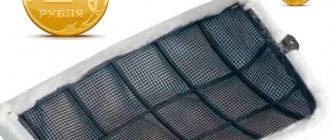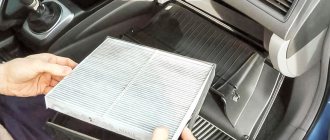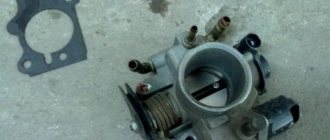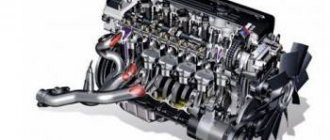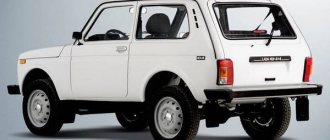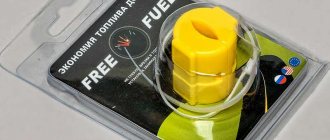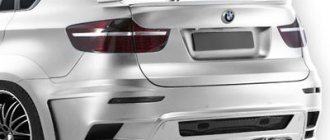Almost all car enthusiasts have a desire to increase the power and dynamics of their car. At the same time, everyone uses their own methods, based on capabilities and level of knowledge.
Some optimize the engine, others install various body kits and spoilers, others use high-quality consumables, and so on.
But experienced car owners know about another popular method - installing a zero-resistance filter.
So what is this device? What are the differences between “nulevik” and standard filters? Is there any point in spending money? Let's figure it out.
Zero resistance filter: what is it?
Air contains many mechanical particles and chemical compounds. First of all, dust that gets into the engine cylinders can damage it. To prevent possible breakdowns, the air must be purified. This requires an air filter that performs mechanical cleaning.
Engine power depends on the amount of air contained in the working mixture. The more air is filtered, the less air enters the engine, and the more power is reduced. Standard paper filters have much greater air resistance because they are made of very dense material. As the filter gets dirty, the pores become clogged, and it generally stops letting anything through, greatly increasing the air resistance.
Its filter component has several layers of cotton fabric impregnated with a special mixture and installed between an aluminum screen. It allows almost unimpeded air flow into the engine. Dirt particles settle on the filter fibers without reducing its throughput. The zero-resistance filter is called that because it practically does not prevent the penetration of air into the intake. Moreover, this property of the “nulevik” does not affect the quality of cleaning. It is for this reason that it is installed on sports cars.
But there is a point
There is a common misconception that by removing the filter and housing you can significantly increase engine power. This is completely untrue.
see also
New crossovers up to 1,000,000 rubles: looking for the best option
It is important to take into account that when developing an engine, a careful calculation of the valve timing is made, which takes into account errors and losses on the filter. And if dust starts to enter the engine, it will definitely not be able to work for a long time. Here it is necessary to have a fence that will prevent the penetration of contaminants. Resistance can be reduced by widening the passage holes. But then the quality of filtration will decrease.
Before looking for a product code and buying a zero for your motorcycle or car, remember one simple truth. For cars without a powerful sports engine, the cost of purchasing such a filter will be absolutely pointless. You will only waste several thousand rubles. The only thing you will get is a slightly changed engine sound.
Nuleviks are only suitable for sports cars and cars with powerful power plants. The use of such a filter on serial engines is allowed only in cases where a comprehensive modification is carried out. That is, boring is done in the cylinders, an enlarged throttle valve is mounted, sports camshafts are installed, etc. You can also put a zero in the kit with them.
How does it work?
For full operation of the internal combustion engine in any vehicle, a sufficient amount of air is required. For this purpose, the engine takes air masses from the atmosphere. However, the air around us is not famous for its cleanliness, for this reason foreign objects (dirt, dust, fluff...) can get into the internal combustion engine, which can cause great harm. To avoid the above process, an air filter is used, which protects the engine from particles of dust, sand and other objects. Factory filters provide an impenetrable barrier to these types of substances, but at the same time they greatly impede the penetration of air at the inlet. In addition, the standard filter gradually becomes clogged, resulting in less engine power.
The zero filter has pros and cons that are very different from the standard one. Firstly, it does not interfere with air intake, thereby the internal combustion engine “breathes deeply” and works without interruption. This is most noticeable at high speeds, because this is where the most air is required. A standard filter cannot cope with such a task at high speeds due to its characteristics.
However, the main task for an air filter is not throughput, but to create a barrier to protect the internal combustion engine from foreign objects. As a rule, zeros are made of synthetics or cotton, and the layer is made as small as possible.
This ensures minimal resistance to air masses at the entrance to the intake manifold.
Reviews
The best indicator of the need to install such a device is reviews from real car enthusiasts. Here are some of them:
Anton, Belgorod.
“I’ve been driving with a zero car for a long time. I did the intake and exhaust at the same time, so the result was significant (like after a good engine chipping). If you install a zero filter on a regular car with normal settings, there will be no result.”
Egor, Kazan.
“I didn’t feel any effect from installing a zero filter. What can be changed by installing a piece of rag?!”
Mikhail, Smolensk.
“When you turn off the engine, there is a unique suction sound that adds to the “sportiness” of the car. I installed a “zero” on the Galant and am pleased. The car felt faster.”
Pros of a zero resistance filter
So, let's list the main advantages of a zero resistance filter:
- Firstly, this is an increased power factor without reducing the quality of air purification. The filter has a more complex design that guarantees low resistance, but at the same time effective filtration, protecting the piston system from wear and the intake system from clogging.
- Secondly, there is no need to change the filter every 15 thousand km. The cleaning component is easily washed with a special liquid, after which it acquires its original properties.
- Thirdly, the zero-resistance filter produces a characteristic sound typical of racing cars and a few additional “horses”. And at medium and low speeds torque appears.
It is worth noting that in order to obtain a noticeable increase in power characteristics and torque, you should remove the standard air filter housing complete with a filter cartridge and install a cone filter - zero, which is selected in accordance with the mass air flow sensor or on the pipe connected to it. with the diameter of the seat.
Useful tips
If we summarize the information received, before equipping your car with a zero auto filter, you need to consider the following:
- a slight increase in power on “prepared” sports cars and absolutely unnoticeable on a standard engine;
- a decrease in filtration quality increases the risk that dust and small particles will get into the motor;
- the need for frequent and more costly maintenance of the zero-resistance filter;
Let us also add that even if it is decided to install a zero filter, it is important to choose the right location for its installation under the hood. In other words, you need to know where to install the zero.
We also recommend reading the article on how often you need to change the engine air filter. This article will teach you when to change your air filter and what to consider when calculating your replacement intervals.
For example, installing a zero in a standard location allows you not to change the standard air intake system, but even minor advantages disappear, since the air flow still worsens.
However, the main reason is hot air under the hood and a drop in power. It turns out that installing a zero resistance filter is not enough. It is equally important to separately think about where to place the zero filter, since installation in a standard location will not bring any results.
We also note that it is customary to remove the zeros completely for the winter. This means that you must always be prepared to return to the place of the standard design. Finally, it is important to buy a good quality zero. The fact is that there are many solutions available on the market.
At the same time, a high-quality original is quite expensive, but it is able to filter the air well, that is, the risks of damaging the engine are reduced. In turn, you can buy inexpensive zero filters from little-known manufacturers, but in this case the quality of filtration is called into question.
Disadvantages of a zero resistance filter
As they say: “It’s not all Maslenitsa for the cat.” Unfortunately, the zero-resistance filter also has a number of disadvantages that can cover all the advantages of this product. We list the main ones:
- The zero resistance filter requires regular maintenance.
- The cost of a high-quality zero filter is several times higher than the price of a conventional filter.
- The driver practically does not feel an increased power of 5-6% when installing a zero-resistance filter, since physically a person cannot perceive a difference in power of less than 5 horsepower.
Air filter manufacturers
We want to highlight the most popular and reputable companies that produce zero-resistance air filters, so that you know exactly whose products you can buy without fear. Of course, you need to make sure that the parts you buy are original.
K&N
Perhaps the most famous company in our country. The quality of their products is always at their best, however, this results in their high cost. In addition to zero cars, they are engaged in the production of cold intake systems, standard air filters, oil filters, cabin filters and various tuners for sports cars.
Official website of K&N products
Apexi
A Japanese company engaged in the production of components for the modernization of automobiles. Their product line is much wider than K&N - there are various accessories, turbo timers, boost controllers, catalysts, ECM (engine control units) and much more. And this company is often called “PEANUTS” in the CIS, for quite obvious reasons.
Official website of Apexi products
Types of “nuleviks”
Zero filters use cotton fabric as a filter element, which is softer in structure than cellulose and does not provide high resistance to air suction. The screen canvas is folded like an accordion, which increases the filtration area.
To increase the effect, manufacturers use special impregnation of the filter screen. A viscous medium is better at trapping the smallest dust particles. Today manufacturers offer two design options:
- dry;
- with impregnation (“wet”).
The location of the filter is not in the normal place.
Filter material in a dry design reduces motor power by 1-1.5%. The impregnated filter provides almost zero resistance and returns lost 5-7% of power to the engine. The cotton screen is impregnated with a special composition, which must be renewed every 2,000 - 3,000 km.
Intake system
Refinement of the intake system is aimed at reducing air resistance at the intake and increasing the volume of air entering the cylinders. The list of elements that require modification or replacement, depending on the degree of “tuning,” includes: air filter, throttle pipe, receiver and intake manifold. Modernization of the intake system will also entail the installation of a direct-flow exhaust manifold, a “supreme” camshaft and changes to the engine control program. Let's look at everything in order.
Zero resistance filter – provides not zero, but significantly reduced resistance to air flow. Standard air filters include a filter element made of very dense material; moreover, the design of such filters is not entirely successful in terms of the amount of air passed through. In zero-resistance filters, the microscopic holes in the filter element allow a much larger amount of air to pass through. This is also facilitated by a large filtration area: the surface area of a “sports” filter is up to five times larger than the area of a standard one. Based on the type of filter element, “zero filters” come in two types. The first option: non-woven cotton material reinforced with metal mesh and laid with corrugation (in common parlance - “mesh”). The second is fine-mesh polyurethane (these filters are called “foam filters”). The “mesh” has less suction resistance, and the “foam” elements retain dust better and have a larger cleaning surface. Therefore, “foam rubber” is used in off-road racing, and “grids”, which are more sensitive to pollution but have less resistance, are used on “asphalt” cars. Some companies make a double filter material: the first stage, with large pore sizes, is responsible for large particles, the second retains fine dust. When choosing a filter, you need to pay attention to the tightness of the connecting pipe, which is reliably ensured only in one way: a rubber cuff as a seal. Many manufacturers, wanting to save money, make the entire body out of plastic and consider the “elastic band” to be superfluous. For circuit racing it may be so. In everyday operation, where the service life of the motor is important, which means a high degree of air filtration, dust “sucked in” through an unreliable seal “finishes off” the motor ahead of schedule.
Filters are washable and dry type. For washable ones, special kits are available for sale, consisting of washing and impregnation. Washing is designed to wash away dirt from the surface of the filter, impregnation serves to retain small particles of dust and dirt, trapping them on the walls of the filter, thereby preventing them from entering the engine. Oil impregnation allows you to increase the size of the filter mesh holes, and, therefore, reduce the resistance to air flow. The filter element in dry-type filters is not impregnated with anything, but is also reusable (washable or blown in the opposite direction).
Filter installation has its own characteristics. To prevent hot air from entering the cylinders, it is important to choose a place in the engine compartment that is as far away as possible from any heat sources. A protective heat shield should also be installed. The filter should not be installed too low - if it gets dirty, it will quickly lose its properties. Cold air intake systems are commercially available. As a rule, they are an aluminum or carbon (depending on the manufacturer) cone, tightly fitted onto the filter element and serving as a screen from the warm air coming from the engine. A corrugation is attached to the inlet, which takes in cleaner and colder air “overboard”. The special shape of the housing and the filter element itself create additional turbulence that helps fill the engine cylinders. As a result, we have: cold air received from the street, reduced resistance due to the zero gear and passive supercharging when the car is moving.
It must be emphasized that installing a zero resistance filter only makes sense when the entire engine has been modified. After all, miracles don't happen. Flow resistance can only be reduced by increasing the passage holes, that is, by deteriorating the quality of filtration. Therefore, when installing a “nulevik” on a standard engine, the game is not worth the candle: it is stupid to get more of a theoretical increase in power by reducing the service life of the engine. In addition, there is an opinion that impregnation of the filter, getting on the measuring element of the air flow sensor, distorts its readings, or even disables it.
The next step is to increase the throttle. An increased throttle reduces air flow speed and helps increase air flow through the intake system. The most budget option is to buy a damper from a more powerful car at a disassembly site, which is installed on your own car.
Next comes the replacement of the standard intake receiver with an enlarged “sports” one. The sports receiver has a significantly larger volume and shorter inlet pipes. A larger volume than the standard one allows, with proper design and configuration, to smooth out air pulsations. The larger its volume, the more sharply the engine will “pick up” after releasing the gas and pressing the pedal to the floor again. Short intake manifolds shift the maximum cylinder filling ratio to the region of high engine speeds. Long intake manifolds ensure good filling and correspondingly high torque at low speeds. Thus, with tight, unregulated intake manifolds, the alternative is either good torque in the low engine speed range and reduced rated power, or high rated power and reduced thrust at low engine speeds. The ideal is an intake system with variable channel geometry, which, depending on the speed and throttle opening, uses different manifold lengths and improves filling throughout the entire speed range.
There are intake systems where the intake manifold in its usual sense is absent as such; instead, short pipes are installed - “pipes”, tuned to certain, usually very high, speeds. They are used when you want to get everything out of the engine and are quite expensive. This is already the highest level in tuning the intake systems of naturally aspirated cars - multi-throttle intake , where each cylinder has a separate throttle valve and manifold. This approach allows you to dramatically increase the amount of air supplied to the combustion chambers. The multi-throttle intake ensures lower idle speeds compared to the receiver and more stable engine operation at low and medium speeds. Well, the engine performance at high speeds is beyond praise. Multiple throttle valves instead of one significantly speed up the car's response to the gas pedal. Side effects: reduced engine life and increased fuel consumption. A multi-throttle intake will only be truly effective when developed for a specific engine. Specialists will have to solve many theoretical problems and conduct a lot of practical tests while they bring their ideas to life. And still, gas dynamics does not fit into the formulas, so after manufacturing the system, calculations, adjustments and new tests are again needed.
Installation methods
There are two options for installing the element:
- standard, using the factory box;
- separately.
A separate air filter is produced in the shape of a cone and is installed instead of the standard element. The part is secured with a clamp on the inlet pipe, and the unit is attached to the body through a metal bracket. Most manufacturers recommend purchasing filters that have a separate installation, promising a power increase of up to 7%.
Drivers note that practically, after installing the “nulevik” in a separate place, the car’s power does not increase. This is due to the fact that the filter takes air from the engine compartment, where it has a low density due to heating from the running engine. The hot air that enters the “nulevik” contains 39% less oxygen than the air that enters the filter installed in its original location.
“Nulevik” for installation in a regular place
Standard installation involves replacing the factory filter with cellulose screens with a new one, without changing the insertion location. The standard factory element has the shape of a box; air is taken from below the engine or near the wing, where the temperature is 3 times lower than above the internal combustion engine.
Replacing a standard part with an improved one allows you to increase engine power, but not by 5-7%, as manufacturers claim, but by 2-3% after checking the car on a dynamometer stand.
Advantages of installing a “nulevik”
Advantages of the Federal Tax Service (compared to standard products) declared by manufacturers:
- Increase in engine power. Moreover, according to some honest manufacturers, it is only 1÷4 hp (although in the descriptions of numerous dealers and sellers of such products it is as much as 7%).
- Improved acceleration dynamics. To be fair, it should be noted that this is precisely the positive factor that users note in their reviews.
- Durability. You really can't argue with that. After all, practically all FNS (both dry and impregnated) are no longer disposable consumables, but serviceable elements of the intake system (after carrying out the appropriate routine maintenance, they are suitable for subsequent operation).
Is it worth betting
Experienced drivers are clear in their conclusions - a zero-resistance filter will help increase power and reduce acceleration time only for a sports car with an engine power of more than 270 hp, since the real engine performance after installing the zero-resistance filter increases by no more than 2%.
For daily trips, the difference of a few “horses” does not matter; the cost of a dry filter is 10 times higher than the price of a factory filter, while fuel consumption is reduced to only a few tens of grams per hundred kilometers.
The impregnated filter must be systematically cleaned, lubricated and reinstalled. This takes a lot of time, the price of impregnation liquid is from 500 rubles per aerosol can.
Sufficient efficiency
A regular foam rubber or paper filter in the box creates a certain resistance, which, at stock parameters, does not create changes in the proportions of air and gasoline throughout the entire speed range. However, as the piston increases, the scooter engine's need for gasoline and air increases. We increase the amount of gasoline supplied by replacing jets and enriching the mixture, in some cases by replacing the carburetor. But the filterbox with the internal element remains the same. It can no longer pass enough oxygen and the scooter runs on an enriched mixture, with all the ensuing consequences. In particular, in this case it is impossible to realize the full potential of the engine.
Service
To maintain the increase in power, you should wash the filter from time to time. To be more precise, it is advisable to clean the filter components every 500-1000 kilometers.
Nothing complicated: clean, rinse, soak, or filter maintenance
How to maintain a zero-resistance filter so that the effect from using this part is maximum? In fact, everything looks like this. The fabric part of the removed filter must first be “dry” cleaned with a clothes brush, removing large foreign particles and contaminants. Then the filter should be soaked with the same notorious “rinsing”. Then, leaving some time for soaking, rinse in water, without being particularly active, however. You need to wash lightly, under a weak stream.
After this, the zero-resistance filter should be thoroughly dried (usually left overnight, but far from heating devices, the part needs to dry completely on its own). Then you should again saturate the fabric part of the filter with the remnants of the “rinsing” so that no light spots remain (that is, quite thick), and only then put it back in place.
The procedure for cleaning and rinsing the filter may differ slightly depending on the treatment product purchased, and the instructions on the package will be your most faithful assistant. The manufacturer always indicates how to properly rinse and saturate the filter with its product.
In fact, official bench measurements suggest that the zero-resistance filter increases engine power by several horsepower at once (about 3 - 7). However, you can’t just feel this offhand with an ordinary production engine. Therefore, installation and, most importantly, maintenance of this part, namely cleaning and washing, is most likely relevant for forced engines, when even the slightest possibilities for increasing power are valued...
Caring for dry zeros
First of all, they must be cleaned of foreign objects; dirt and dust should not linger on the filter for long, as this weakens the throughput of the product. A soft bristle brush or a regular toothbrush is best for cleaning. After this, you should use a special washing liquid, most often it comes in the form of a spray. Next, you need to wait 15 - 20 minutes, then run the soaked filter under a stream of clean water. It is not recommended to wash the filter with tap water. After the filter has been washed, it must be dried. Hair dryers and other household appliances should not be used. After the filter has dried, you can put it back in place and continue to use it.
Caring for wet zeros
The maintenance process for wet filters is practically no different from dry filters. There is only one difference. After all cleaning of the nulevik, it is additionally impregnated with a special liquid, which provides a barrier to foreign objects.
How to care for such filters?
As already mentioned, one of the main disadvantages of the filter is the need for regular maintenance.
After purchasing and installing the product, it must be washed and treated regularly. In this case, processing according to the “remove-wash-install” principle will no longer work - a special algorithm is required here.
The frequency of washing is every 5-6 thousand kilometers. If the car is operated in dusty areas or off-road, then the filter must be cleaned more often.
If you forget about servicing the device, the machine becomes “gluttonous” and “dumb.”
The algorithm of actions is as follows:
- remove the zero filter from the machine and remove all dust from it using a special brush;
- Wash the unit in a special container with a special cleaning solution, then rinse the filter under water pressure;
- shake off the filter element and inspect it. If there are light spots, the filter needs to be impregnated with a special agent;
- treat the product with a special impregnation (as a rule, it is sold separately from the “nulevik”);
- return the “zero” to its original place.
There are even special kits for caring for “nuleviks”, which include washing and impregnation. A few manipulations as described above, and the product looks like new.
Please note that the total number of washes can be limited and is about 20 pieces. After this, it is worth installing a new filter.
Why is this necessary?
First, let's figure out what it is and what it is eaten with. A standard or regular air filter is designed to clean the air entering the engine from all kinds of contaminants. It is due to air filtration that power loss occurs.
This is due to the fact that the cleaning elements in the filter design (usually special paper) create resistance to air flow. This is not surprising since the filtration material is very dense. And the higher the resistance, the more the final power is lost. As you know, increasing power is achieved by increasing the amount of incoming air. This is where the zero impedance filter comes into play.
Nulevik is an alternative to the standard cleaner. Its design is such that the device reduces intake resistance without sacrificing air purification itself. This results in an increase in power.
And here a logical question arises: is your Priora, VAZ 2112 or VAZ 2114 worthy of such an element? Is it even worth buying a zero car if you want to slightly increase engine power?
Practice and research show that such a small tuning as installing a zero level allows you to get an increase of 3-5% in power. If this is a low-power car, then you definitely won’t feel an increase of several horsepower. You also won't see any difference in dynamics. But the numbers will be higher than you can comfort yourself a little.
Key Benefits
Reading reviews about nuleviks, I came across many conflicting opinions. One installed such a filter on his injector and was very pleased. Another spent a lot of money on a K&N zero and its installation, wanted changes, but in the end all he got was wasted time. And there are many such examples.
I’ll say right away that ordering zero-resistance filters from auto stores is not a problem at all. The price for some models is quite reasonable, so it is not difficult to buy and is relatively inexpensive. But whether such an element needs to be installed on a VAZ with your own hands is an extremely interesting question.
Let's start with the good. Like any device, the Nulevik has its pros and cons. The disadvantages include the cost compared to a conventional air filter and the need for constant cleaning.
As for the advantages, there are several of them.
- Power increases. The nulevik has a complex design that allows it to reduce resistance. This gives an increase in horsepower;
- Simultaneous cleaning efficiency. Although the resistance drops, this does not affect the quality of air purification;
- Replacement frequency. There is no need to change the nulevik as often as a regular filter. They are washable. This allows you to return full performance characteristics;
- Increase in characteristics. Albeit a little, but the zero gear adds power and increases torque;
- Sound. For many, it is not the power that is important, but the sound characteristic of powerful engines. Nulevik creates such an effect, and as a result the car sounds very interesting.
To achieve what you want, you will have to remove the standard filter and install a zero-resistance device in its place. Decide for yourself which is better, buy and install it yourself, or give the car to the experts. In the second case, there will be a guarantee of quality and a well-chosen filter. The main thing is that the specialists themselves are qualified and reliable.
How does cold air affect the engine?
on the contrary, it’s good, it’s not just that srakers install all sorts of intercoolers
The density of cold air is correspondingly higher and the power is also higher for turbo engines. I think Srakers will explain better.
I’m not an expert, but I drove turbo diesels at -50, and now even with gasoline engines I make a intake from the manifold for the winter. they forgot the UAZs, but in vain..
What will the cold air do to him?
The breather doesn't seem to catch
It's better to take hot air
cold air does not burn well. heavy and dry.
Foreign cars are not designed for such frosts and therefore they do not have an air intake from the manifold.
Clearly this means nothing critical will happen)
The engine is already whispering, insulated with a tarpaulin on the bottom and a car blanket from the child on top, plus cardboard in front of the radiator
How does cold air burn poorly?
Arabs in the desert at races throw ice on the intercooler and weld a special compartment. in order to cool the air entering the engine. Dredgers are thrown into the air box onto dry ice. The intercooler is probably watered with liquid nitrogen because hot air burns well?
too hot is also bad. Well, minus 50 is clearly not going to do any good.
Cold air has more oxygen and will ignite better, thereby increasing engine power and reducing fuel consumption. I have experience, I still drive and am happy with the Chevy
if an individual does not understand why, at -30 and below, there is an air intake for the engine from the manifold, especially for a turbodiesel, then what can we even talk about with him, but on gasoline vehicles there is a lambda probe (oxygen sensor), and gasoline begins to flow ..
gasoline will be hot if it's warm
so basically the engine doesn’t care about cold air, all summer dacha owners don’t like the oxygen system
it throws more fuel
Agree. Cold air even adds a little strength to the engine, because... it is compressed, but the sensors do not process it well and cause it to pour too much gasoline! Therefore, it is still better to take warm air from under the collector.
I googled it, the intercooler cools the air to 50-60 C
if it’s 40 degrees outside, the air will be 0
But not -50, can you hear the difference? Do you like to drink boiling water? You cool the tea, but you don’t bite ice instead of tea. So everything is good in moderation.
Tell that to the brand makers
at -50 the air flow sensor starts to go crazy and the outside temperature
The thermometer in Japanese only shows up to -30. It starts to float at idle, and when it sits for a while it returns to normal.
Today I noticed oil leaks at the inlet and outlet of the intercooler.
But I don’t think that the frost is to blame, although I don’t know. The car is only a year old hino 300 euro 4 mileage 25000
For a turbo engine, it doesn’t matter where the air comes from.
After the air filter, the air enters the turbine, heats up, and then into the cylinders. To cool the air after the turbine and increase its density, respectively, the amount of oxygen in the mixture, it is passed through an intercooler. Oil appears in the intercooler when the turbine dies.
The more air, i.e. oxygen, is better for the engine.
To increase the flow, it is compressed, that is, a boost, turbine or compressor is used. cooled air is even denser.
How did the turbine pass through 23,000 current?
It’s strange, but the oil is consumed in the winter; I added 2 liters of oil and changed it 3000 km ago.
This is how you need to do it: take warm air from the engine if it’s overboard - 36 - 45 I still don’t understand you
Source
The myth about the cold air intake of the car has been destroyed. Do you still believe in cold intake?
So, with full stock and a clean air filter, we squeezed out 228 horses. With a homemade front zero, we got 232 horses. In the last issue, we said that a 10% increase in power will be noticeable. In our case, comparing the standard filter and the cold intake, we are talking about an increase of 1.8%, which you definitely will not feel. But still this is an increase that is noted by the dyno and repeated tests. If you get a little smarter, you can squeeze out a little more power, and with us every little thing counts. Perhaps if you are chasing dyno numbers and you have 199 horses and are aiming for 200s. Then by installing such a thing, you will achieve the desired level, but in our case it’s not worth it
It is worth taking into account that if you place a zero somewhere below the bumper, then when entering a puddle you will take a sip of water, and your engine will produce 0 horsepower. Such a risk is not worth such a 1.7% increase in power
If you, say, live in South Wales, then this thing will only attract attention.
To improve engine performance, you can begin to filter the supply of oil and other substances from the crankcase exhaust gases.
Chip tuning of Lada Kalina 16V compressor engine!
Chip tuning of a car and measuring power on a dyno.
You can increase engine power and torque without disassembling using chip tuning, which means “tuning” or “adjustment”. This is one of the popular methods for tuning an engine with an electronic control unit (ECU).
Source
Subaru tuning. Part 8.
One of the most radical tuning methods that gives maximum effect is to increase engine displacement. Torque directly depends on the filling of the cylinders with the working mixture: the greater the filling, the higher the engine power. The optimal value of this parameter can be achieved through complex actions, which we will discuss a little later.
But when making changes to car systems, it is very important to remember that the engine unit has certain capabilities and limitations in terms of strength and reliability. Haphazard tuning will not only not improve performance, but can lead to destruction of the existing engine
For example, you can increase the power of a 1998 Subaru Impreza WRX STI with a stock engine to no more than 450 hp. If you try to add additional “horses,” the piston group will collapse, the cylinder block will burst, connecting rods will fly, etc.
To choose the right sequence of work, it is important to determine the end goal. If you want to increase the power of your car by 150 hp
for city driving, you need to start by installing larger injectors and a turbine with the appropriate characteristics. For sporty driving with a power increase of 700 hp. You must first carry out all the work to strengthen the engine itself, modify it, expanding its capabilities relative to the standard model. Modernizing the engine block is the most profound and expensive type of tuning, so if you have serious intentions and financial capabilities, you need to understand its directions.
Next, read about engine overhaul - replacing the crankshaft, pistons, connecting rods.
Source
Turbocharging
This method is deservedly considered the most effective in terms of increasing the power of the power plant. This is evidenced by the growing number of models produced with such an option (turbocharged modifications are not uncommon today even for the AvtoVAZ concern).
However, even owners of turbocharged cars have something to strive for, since they also have many opportunities to increase the amount of horsepower produced by the engine. Such tuning is especially interesting for owners of low-power cars (for example, with an engine capacity of 1.4-1.5 liters). In order to achieve even more impressive results, it is enough to install a larger turbine. An alternative option is to increase the pressure of the factory turbine. All these methods allow you to achieve a noticeable increase in power, but require a considerable number of changes. Instead, you can choose a turbine with higher performance; fortunately, there are a huge number of models on the market for most running models.
If we talk about installing a turbine on an atmospheric power unit, then this is already considered a fundamental change in the design of the car, affecting both engine settings and operational issues (the need for mandatory warming up of the engine, even in the hot season, more frequent replacement of consumables).
However, the gain in power can be almost double, so this work is worth the effort. It all depends on your skills, as well as the characteristics of the installed turbine. True, in addition to the turbine itself, you will also have to install an intercooler, since it becomes very hot during operation, and the engine also heats up along with it. To reduce the thermal load, some increase the volume of coolant entering the radiator and improve its airflow by installing a more powerful fan. Old nozzles also need to be replaced with more efficient ones, since they are not designed for such a large load.
The principle of operation of a turbocharger is quite simple - providing a much larger amount of air into the cylinder. And since the intensity of the combustion process depends to the maximum extent on the presence of oxygen (remember, there is little of it in atmospheric air - about 21%), then the more air enters the combustion chamber, the better
By the way, the turbine is driven by exhaust energy without using engine power, but it must be taken into account that there is a direct relationship between the accelerator pedal pressure and the performance of the turbine
The advantages of this method of increasing the power of the power unit are obvious: in terms of efficiency (a twofold or more increase in engine efficiency) there is no alternative to it; the use of the turbine can be canceled at the touch of a button if there is no need for it.
But this is also the most expensive method, and also requires flashing the on-board computer software. It is also unrealistic to install a turbine yourself - this requires appropriate experience and knowledge. Although powering the turbine does not require engine power take-off, increased fuel consumption is inevitable at high speeds - this is required by elementary physical laws. Installing a turbine requires significant modification of many other components of the machine - the use of more durable parts, increased braking capabilities. Finally, get ready for the fact that the engine life will obviously be less than the specified one.
